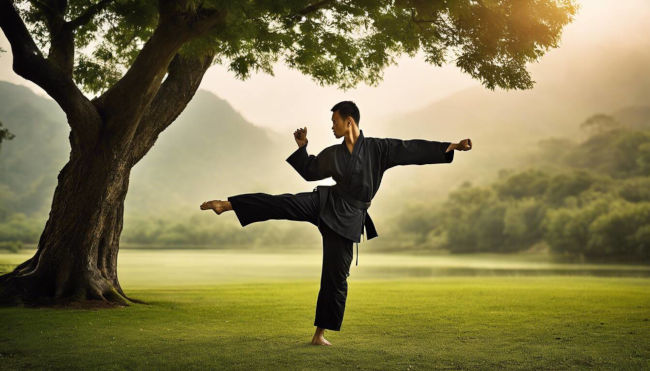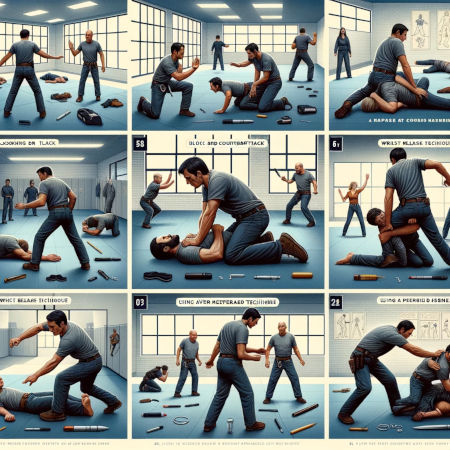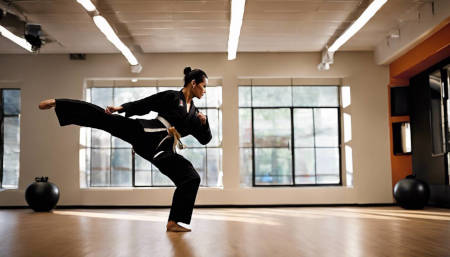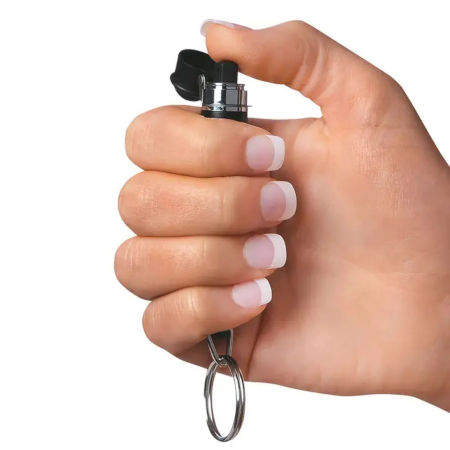Self Defense Tactics

Martial arts provide valuable tools for self-protection, drawing from a range of disciplines like Krav Maga, Brazilian Jiu-Jitsu, Muay Thai, and Taekwondo. Each system embodies unique strategies geared towards real-world situations; for instance, Krav Maga is all about swift, practical responses while Brazilian Jiu-Jitsu focuses on ground combat and neutralizing stronger opponents. Surprisingly, these techniques not only equip you for physical defense but also cultivate mental strength and assertiveness, essential for de-escalation and navigation of threat scenarios._prepare to dive into the specifics.
One effective self-defense tactic is the use of a pepper spray, such as a keychain version you will always have with you, or a portable personal alarm that emits a loud sound to attract attention and deter potential attackers. Another tactic is learning basic striking techniques, such as palm strikes or knee strikes, which can be used to create distance and escape from an assailant. These tactics can provide individuals with valuable tools to enhance their personal safety.
The Mace Keyguard® Mini Pepper Spray Black
Martial Arts Techniques for Self Defense
Martial arts encompass a wide array of combat techniques refined over centuries across different cultures. Each discipline presents a unique approach, philosophy, and principles when it comes to self-defense. Let's delve into a few disciplines and explore the invaluable skills they offer.
Krav Maga, for example, is a self-defense system developed for the Israel Defense Forces, renowned for its focus on practical and effective methods tailored for real-life situations. The emphasis here lies not in elaborate moves or traditions, but in instinctive movements aimed at swiftly neutralizing threats. Practitioners are trained to identify and respond to potential dangers with quick, decisive actions. The goal is to neutralize threats swiftly, focusing on vital points rather than engaging in prolonged combat.
In contrast, Brazilian Jiu-Jitsu (BJJ) specializes in ground combat and self-defense against stronger opponents. It teaches individuals how to use leverage and proper technique to defend themselves effectively, even when faced with physical disparity. BJJ's focus on grappling and submission holds makes it particularly effective for defense in close-quarters situations.
Imagine being able to defend yourself against someone much larger and stronger by using their force against them. That's the kind of skill Brazilian Jiu-Jitsu offers.
While Muay Thai equips individuals with powerful striking techniques using fists, elbows, knees, and shins, Taekwondo emphasizes fast kicking techniques and dynamic footwork. Both disciplines cultivate agility, speed, and precision, enabling practitioners to defend themselves from a safe distance.
Each martial art form offers unique skills geared towards self-defense in diverse scenarios. By learning from these diverse disciplines, individuals can develop a versatile set of abilities that prioritize defense, de-escalation, and neutralization of threats—a crucial foundation for self-protection.
Armed with an understanding of these diverse martial art forms and their contributions to self-defense, we can now shift our focus to fortifying the body for optimal martial self-protection.
Strengthening Body for Martial Self-Defense
When it comes to self-defense, having a strong and agile body is just as important as knowing the right moves. Think of your body as the tool that you need to keep sharp to be prepared for any challenging situation. Physical conditioning and martial arts training are essential elements in mastering self-protection.
Physical Conditioning
First things first, regular physical exercises like strength training, cardio, and flexibility routines work together harmoniously. They don't just make you look fit; they also improve your overall physical health, endurance, and agility - all crucial for effective self-defense.
Now, when we say strength training, picture exercises that help build muscles, making you stronger and more capable of quick and powerful moves if you're ever in danger. It's not just about lifting heavy weights; it's also about enhancing muscle endurance so that you can sustain your ability to defend yourself for an extended period without getting tired quickly.
Cardio is about improving heart health and stamina, allowing you to keep moving for longer periods without feeling exhausted. Imagine having to run away from an attacker or needing the energy to fight back if necessary - this is where cardio comes in handy.
Finally, flexibility is often overlooked but is incredibly important. Being flexible means that your body can move through its full range of motion without feeling tight or restricted. This helps in executing techniques smoothly and efficiently.
Let's consider an example here - think of a martial artist who needs to fend off an attacker. The strength comes in handy when executing powerful strikes or grappling with an opponent, cardio helps with sustained energy during a struggle, and flexibility ensures swift and effective movements.
Martial Arts Training

Next up is martial arts training, which provides a specialized form of physical development. Engaging in specific martial arts practices enhances not just physical attributes but also mental discipline.
By engaging in martial arts training, individuals enhance their strength, balance, coordination, and muscle memory. These elements are crucial for executing self-defense techniques effectively in high-pressure situations. These practices increase your ability to remain calm and composed even when faced with intense or aggressive situations.
For example: Imagine being in a position where you have to protect yourself or someone else from harm. Your martial arts training will help kick in those instincts that you've drilled again and again. It's not just about the moves themselves - it's also about building muscle memory so that these techniques become second nature under stress.
As we've seen, physical conditioning and martial arts training play crucial roles in preparing individuals for effective self-defense. Now, let's explore how mental preparedness factors into mastering self-protection.
Mindset Development for Self-Protection
In martial arts, training isn't just about punching and kicking. It's about preparing your mind to handle difficult situations. Imagine being in a crowded space, and something just feels off. That's your mind's instinct telling you to pay attention. Situational awareness is all about learning to trust those instincts and developing a sense of what's normal for any given situation.
Enhancing Situational Awareness
When you're walking down the street, are you aware of who's around you? Are there any unusual sounds or sights that catch your attention? This heightened focus is an essential aspect of protecting yourself against potential threats. It helps you identify escape routes, spot suspicious behavior, and react promptly.
Confidence and Composure
Building self-confidence is also a vital part of being able to protect yourself. Picture a person trying to start a fight with you. If you stand tall, look them in the eye, and speak clearly, they're less likely to see you as an easy target. But if you look nervous or scared, they might think they can take advantage of you.
Confidence is gained through practice and conditioning, much like physical strength. Training in martial arts hones not only your physical skills but also your mental resilience. In challenging circumstances, maintaining composure can be the difference between being able to de-escalate a situation or falling prey to panic.
By practicing scenarios where you have to stay calm under pressure, whether it's a sparring session or visualization exercises, you prepare yourself for real-life encounters. This not only enhances your ability to defend yourself physically but also mentally enhances your capacity to make quick decisions during high-stress moments.
Just like mastering physical techniques, honing your mental and emotional approach to self-defense takes time and effort. It's an essential part of being prepared to protect yourself effectively in various situations.
Strategizing Against Threats Efficiently
When it comes to self-defense, being prepared and having a plan can make all the difference. Understanding vulnerabilities is the first step in building an effective defense strategy. This involves identifying your own personal weaknesses and potential tactics that attackers might use. By pinpointing areas where you may be vulnerable, you can better prepare yourself for any situation.
For example, if someone attempts to grab you from behind, learning how to break their grip and quickly turn around could potentially save your life.
So, by understanding your vulnerabilities, you can tailor your defense strategies to address those weak points and become more well-rounded in your ability to defend yourself.
Moving on from vulnerabilities to the next crucial aspect: Legal Knowledge.
While it is important to learn practical self-defense techniques, understanding the legal aspects of using these techniques is equally crucial. Laws governing self-defense vary from place to place, so knowing what actions remain within lawful boundaries can prevent legal repercussions.
To illustrate this further, let's consider a scenario where someone tries to attack you, and you successfully defend yourself using physical force. In some locations, the law allows for the use of force in self-defense only when facing imminent threat or harm. Understanding these laws ensures that your actions align with legal rights and limitations.
Without legal knowledge, your ability to protect yourself could come with serious consequences. It's essential to comprehend when and how self-defense can be legally used, ensuring that your actions are justified and legally defensible in case they are scrutinized.
Developing a deep understanding of vulnerabilities and legal boundaries significantly contributes to an individual's capacity to respond effectively in self-defense situations. These crucial components form the foundation for creating a comprehensive and efficient self-protection strategy.
A seamless transition from understanding vulnerabilities and legal boundaries to implementing tactical martial skills plays a pivotal role in building a robust plan for mastering self-protection.
Building Tactical Martial Skills

When it comes to self-defense, mastering martial arts techniques can provide a significant advantage in protecting oneself. One essential aspect is being able to anticipate and defend against different types of physical aggression. Let's break it down.
Defensive Maneuvers
Solid training in various defensive maneuvers like blocking, striking, joint locks, and grappling forms the backbone of effective self-protection.
These techniques are not only about overpowering an assailant but are also aimed at neutralizing threats while minimizing harm to oneself and others. When you can fend off blows and control an aggressive encounter, you're better equipped to defend against physical aggression.
When practiced consistently, these defensive maneuvers become second nature, enhancing your ability to defend yourself effectively in chaotic situations.
Weapon Defense
In today's world, there's a pressing need to be prepared for potential dangers involving weapons. Learning how to defend against common weapons like knives or blunt objects significantly improves overall self-defense readiness.
Defending against weapons requires precision and quick thinking. It involves learning specific techniques to disarm an attacker and minimize the risk of injury to oneself or others present. This advanced skill set is crucial for staying safe in real-life threatening situations.
Furthermore, honing weapon defense techniques goes beyond physical movements. It also involves understanding an assailant's psychology and the dynamics of weapon-based altercations. By doing so, individuals gain the necessary know-how to respond intuitively and effectively, maximizing their chances of survival in potentially life-threatening situations.
In this way, building tactical martial skills involves training not only in physical maneuvers but also in mental preparedness for high-stress scenarios—empowering individuals with the expertise and composure needed for effective self-defense.
Comprehensive Self-Defense Training Approach
Self-defense encompasses more than just knowing how to throw a punch or a kick. It's about being prepared for any situation and knowing the best ways to protect yourself. A comprehensive self-defense training approach involves various aspects that merge to ensure your safety and security in diverse scenarios.
Physical Training
When it comes to self-defense, physical training focuses on teaching you how to defend yourself in physical altercations. This includes learning striking techniques, grappling, and other combat maneuvers that can help you fend off an attacker. These physical skills are essential, but they are only one piece of the puzzle.
Legal and Ethical Understanding
Understanding the legal and ethical aspects of self-defense is crucial. Knowing when and how to use force in self-defense, and understanding the laws and regulations pertaining to self-protection, is vital for responsibly protecting yourself.
Self-defense law can vary by country or state, so it's important to know what is legally permissible where you live. Understanding legal aspects also includes knowing how to de-escalate a situation before it turns violent and being aware of the potential consequences of using force in self-defense.
Mental Preparedness
Mental preparedness is about developing the right mindset for potentially dangerous situations. It involves staying aware of your surroundings, recognizing potential threats, and being mentally ready to respond if needed. This aspect also includes managing fear and stress during high-pressure situations so that you can act decisively and effectively if faced with danger.
A key part of mental preparedness is developing situational awareness - being tuned into your environment at all times.
Tactical Skills
Tactical skills go beyond physical combat techniques. They involve learning how to assess a situation quickly, identify escape routes, and make smart decisions under pressure. Understanding how to use your environment to your advantage and planning effective responses are crucial components of tactical training.
Use of Self-Defense Products
In today's world, self-defense products such as pepper sprays, stun guns, and personal alarms play a significant role in enhancing personal safety. These products offer an added layer of protection in various situations, providing individuals with a means to protect themselves when confronted with potential threats.
For example, pepper spray can provide a non-lethal means of defense against attackers at a safe distance, while personal alarms can attract attention in emergency situations.
This multi-faceted approach recognizes that effective self-defense involves not just physical skills but also legal knowledge, mental readiness, tactical decision-making skills, and the integration of modern tools like self-defense products into one’s personal safety strategy. By combining these elements, individuals can better prepare themselves for real-world threats and enhance their overall security.
By offering self-defense products such as pepper sprays, stun guns, and personal alarms on our website at TBOTECH, we provide individuals with access to practical tools that can help them bolster their personal safety strategies in various circumstances.
In the pursuit of mastering self-protection, integrating these diverse elements into one's training regimen forms a robust shield against potential harm. Striving for comprehensive readiness equips individuals with the confidence and ability to effectively navigate varying dangers they may encounter.
Add your comment now!
Post Comment




